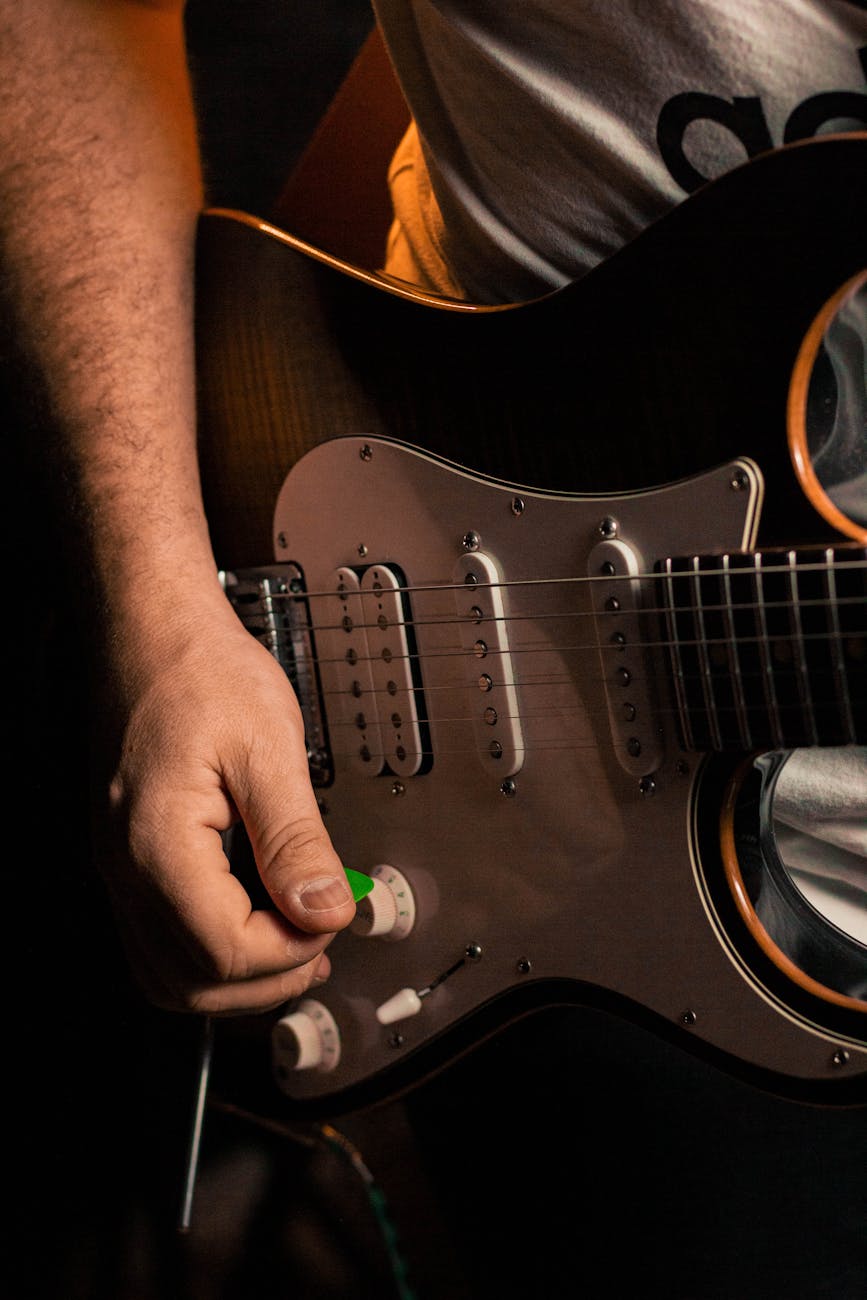
You’d be surprised how many iconic riffs and unforgettable songs are built on this simple foundation. Learning rock guitar basics for beginners doesn’t have to feel overwhelming, that’s the beauty of starting with just three chords.

Whether you dream of nailing that first solo or rocking out to your favorite band’s hits, this guide will show you how to make your guitar journey fun, straightforward, and entirely doable, starting right now with the essentials.
Don’t overcomplicate it, grab your pick, find those frets, and let’s make some noise!
For more beginner tips, be sure to check out this beginner guitar checklist for learning rock music.
Learning to play rock guitar can feel like scaling a mountain, but here’s the truth: you don’t need to know every chord in the book to sound amazing. G, C, and D are your golden tickets to rocking out right now.
Add in power chords, and you’ll feel like a rock star in no time. Let’s break it down. Check out Three Chords & The Truth by Guns n Roses bassist Duff McKagan.
The chords G, C, and D aren’t just beginner-friendly; they underpin rock classics. These three chords are like the swiss army knife of rock, versatile and powerful.
Think of them as the holy trinity of rock guitar. Seriously, so many iconic songs are powered by just these chords! Songs like “Sweet Home Alabama” and even “Wild Thing” draw their groovy vibes from this simple combo.
Why start here? They’re easy to learn, sound amazing, and help build confidence.
They’re perfect stepping stones to more complex progressions. Plus, practicing these chords solidifies finger positioning and coordination, which every beginner needs to master.
Want more help on learning chord basics? Check out this beginner rock guitar guide for tips to get started!
If G, C, and D are the heartbeat of rock, power chords are its soul. These chords strip things down to their essence, just two notes, the root, and its fifth. That’s it!
All you have to do is fret two strings and strum. The result? A thick, crunchy sound that screams “turn the volume up!”
What’s great is that power chords are movable. Learn one shape, and you’re good to go. Slide up or down the fretboard, and suddenly, you’ve unlocked dozens of songs without breaking a sweat!
From “Smells Like Teen Spirit” to Green Day’s “Basket Case,” power chords dominate rock playlists. Dive deeper into mastering these beauties with this guide to beginner power chords.
The biggest frustration for beginners? Choppy chord changes. We’ve all been there. That awkward pause while your fingers scramble to the right positions?
It’s totally normal. The trick is to minimize that downtime.
Remember, it’s all about familiarity. Your fingers gain muscle memory with repetition, and eventually, you’ll make those changes without thinking.
Another great tip? Use simple tracks to practice. For more advice, check out this beginner rock guitar lesson that emphasizes rhythm and technique.
When you’re just starting your rock guitar journey, there are some key skills you’ll want to lock down right away. These aren’t just random exercises, they’ll help you sound better, faster.
Let’s focus on four essentials every beginner should master: strumming patterns, palm muting, practicing riffs, and timing with a metronome.
Strumming drives the rhythm of a song, and in rock music, it’s the backbone. For beginners, starting with downstrokes and simple variations is the way to go.
Focus on steady, even strums to develop muscle memory. Once you’re comfortable, mix in upstrokes to add texture.
Try this beginner-friendly exercise:
It’s okay if it sounds stiff at first. Practice will clean it up.
Need more help? Check out some strumming tips from this Beginner Electric Guitar Lesson. You’ll see how tiny tweaks make a big difference in your sound!
Palm muting is how rock guitarists create that chunky, percussive sound. It’s a technique that gives your playing dynamics, light and soft one moment, heavy and bold the next.
And guess what? It’s easier than it looks.
You’ll often hear palm muting in songs like “American Idiot” by Green Day. It’s a small trick that makes your guitar growl. Dive deeper into this technique in the Rock Guitar Basic Techniques Guide.
Nothing feels cooler than playing a recognizable riff. Not only is it a blast, but riffs also teach timing, positioning, and flow.
Start with straightforward songs like “Smoke on the Water” by Deep Purple or “Seven Nation Army” by The White Stripes. Both rock classics are based on single-note patterns that beginners can handle.
Here’s a quick tip: Focus on playing slowly and cleanly before trying to match the tempo of the song. Speed is worthless without clarity.
Learning riffs isn’t just fun, it builds confidence. Plus, exploring riffs is a great way to stay motivated. If you’re ready to learn more, check out this guide on Rock Guitar Basics.
Timing is everything in rock. Without it, even the coolest riffs fall apart. Practicing with a metronome helps train your internal clock while building rhythm.
Think of it as your personal “drummer” who never messes up.
It might seem boring at first, but trust me, it’s worth it. Perfect timing separates “just okay” players from great ones.
Need more guidance? This practice guide for guitar picking styles shows how using a metronome can elevate your playing.
These skills, strumming patterns, palm muting, riff practice, and timing are foundational. Master these, and you’ll be well on your way to jamming like your favorite rock icons!

Starting out with the electric guitar can feel a bit like stepping into an entirely new world. What do you really need to get going? Don’t worry, I’ve got you covered.
Let’s break it all down so you can practice and play without stressing over your setup.
Read More:
Selecting your first electric guitar is like picking your sidekick for an epic journey. You need something reliable, comfortable, and perfectly suited for rock.
For beginners, affordability and playability are key. You don’t need a $2,000 guitar to sound amazing starting out, but you do need one that feels good in your hands and stays in tune.
Here are a few insights to get you started:
Curious about affordable and reliable beginner models? Check out this beginner’s guide to affordable electric guitars. It’s got plenty of recommendations you’ll love.
You’ve got the guitar, great! But there are a few accessories that make playing so much easier (and way more fun). Think of these as the unsung heroes of your rock journey.
Here’s what you’ll need:
Pro tip: If you’re totally new to working with gear, it might help to peek at this gear must-have list for electric guitarists, especially if you’re unsure what to buy.
Amps and effects are where the magic happens. You can play a guitar unplugged, sure, but rock is all about that amplified, gritty tone.
A simple practice amp is a must for beginners, and many come with built-in effects (score!). Here’s what you need to know:
Want some help figuring out amps and effects? You’ll want to explore this guide to beginner gear for playing electric guitar to make sense of it all.
Rock tones are as much about experimenting as they are about playing. Plug in, twist dials, and don’t shy away from cranking the volume (well, just not at midnight).

Consistency is the secret sauce when you’re learning to play rock guitar. Creating habits that stick and building momentum over time is the way to go.
Let’s break down some straightforward strategies to help you stay on track and keep shredding.
Start small and think progress, not perfection. Setting realistic milestones keeps you from feeling overwhelmed while giving you something to celebrate.
Ask yourself, “What’s doable for me every day?” If an hour feels like too much, no problem. Aim for 15-20 focused minutes instead.
For beginners, getting comfortable with three foundational chords like G, C, and D makes a great starter goal. Learn them cleanly, practice switching between them, and then move on to rhythm exercises.
Want to set goals that align with your learning style? Make sure your plan feels achievable but a little challenging, it keeps things exciting and engaging.
A consistent routine breaks through the “I’m not in the mood” phase. Try setting a specific time every day for practice, even if it’s just 20 minutes.
Pro tip: Treat it like brushing your teeth, not optional. The easier you make it to show up (like keeping your guitar easily accessible), the more likely you’ll stick to it. Here are some ideas to structure your sessions:
Want to explore more ways to build a fun routine? Check out this guide to avoiding guitar burnout for tips on keeping your practice fresh and enjoyable.
Let’s be real, nothing fuels motivation like playing a song you know. Starting out with easy, iconic rock tracks gets you excited and gives you tangible results. Here are a few beginner-friendly songs worth a shot:
These songs are simple but packed with that rock ‘n roll soul. Turn on the original track and jam along, it makes practice feel less like a chore and more like a concert in your bedroom.
Being a part of a guitar community can be a total game-changer. Whether it’s online forums, local guitar meet-ups, or even social channels, connecting with others who share your passion adds accountability and inspiration.
Look for beginner-friendly spaces where no question is too small or silly. Online guitar groups often share tips, song recommendations, and even live jam sessions.
Plus, you’ll find folks celebrating milestones like mastering their first chord progression, proof that everyone starts somewhere.
Curious to learn more about building connections in the guitar world? Check out this approach to motivation and sticking with your practice over at Finding Inspiration in Guitar.
Remember, it’s about progress, not perfection. Showing up daily, staying inspired, and surrounding yourself with like-minded players keeps the journey exciting. Keep rocking!
Kicking off your rock guitar journey is beyond exciting, but let’s be real, it can get overwhelming without the right tools.
The good news?
There’s an entire world of learning resources designed to get you strumming with confidence quicker than you think.
Whether you’re a bookworm or a fan of online videos, someone has already made learning rock guitar easier for you. Let’s dive into some of the best resources to speed up your progress.
Books are often underestimated these days (remember those?), but they’re PACKED with timeless advice and thoughtful lessons.
Starting with the right book is like having a personal coach by your side. Here are some beginner-friendly options that I recommend:
These books aren’t just about learning chords, they walk you through rhythm, strumming, and even ear training.
If you’re interested in how books like these stack up in teaching the fundamentals, take a look at the How to Play Rock Guitar for Beginners guide for more ideas.
When you can’t schedule lessons with a pro face-to-face (or simply don’t want to), the internet steps up.
Platforms like YouTube, Fender Play, and apps make learning guitar feel less lonely, and you get instant visual feedback.
Here’s a shortlist of beginner-friendly online resources:
Apps also offer fun ways to practice between lessons. Platforms like Simply Guitar turn practice into a game, showing real-time feedback on how well you nailed that riff.
If you’re curious about more ways technology helps beginners, check out Rock Guitar Lessons For Beginners: Rock 201, loaded with helpful strategies!
Ever wonder why pro athletes watch tape of their own moves? In football games, watch the players look up at the Jumbotron right after a play.
The same logic applies to learning rock guitar. Recording your practice sessions lets you catch things you might miss in the moment, like a sloppy chord change or inconsistent strumming. It’s like hearing yourself from the audience’s perspective.
Progress tracking with recordings not only improves your skills but also builds confidence.
Need more tips on how to level up? Check out the guide to nailing your first guitar solo, which highlights more beginner-friendly strategies for self-improvement.
Every beginner hits roadblocks, but equipping yourself with these resources will push you through them faster.
Keep experimenting with different tools until you find what works best for you. Whether you’re deep into a book, plugged into an app, or hitting pause-and-rewind on YouTube, don’t stop.
Progress might be slow at first, but it’s consistent.
Building riffs is like crafting stories using the chords and notes you already know. Don’t overthink it, creativity loves simplicity.
Here’s how to start:

Every great riff starts somewhere simple. Think of it like building Lego, the foundation matters, but the look is up to you.
Slice new ideas from classic concepts, just as scales and patterns help unlock improvisation. If you’re curious about expanding fretboard knowledge or experimenting further, visit this handy guide on guitar fretboard and note improvisation.
What makes riff creation even better? It builds confidence. Finger familiarization improves, and suddenly, you’re not “practicing”—you’re playing. And that’s what this journey is all about.
Now grab your guitar and see where those strings take you! Grab a riff, make it your own, and let the rock energy flow.
Starting your rock guitar journey with just three chords and some basic techniques is the quickest path to sounding amazing. G, C, and D open doors to countless songs, while power chords and steady practice cement your foundation.
The goal isn’t perfection—it’s progress, and every step you take builds confidence.
Next, put this into action by trying simple tracks like “Wild Thing” or experimenting with your own riffs. Want more support? Check out this guide to rock music theory for beginners to grow your skills even faster.
Pick up your guitar, plug in, and keep it fun. The thrill of playing rock comes alive when you focus on progress and enjoy the music.

I’ve been playing guitar 40 years now; writing, recording, and rocking in bands. Randy Rhoads, Warren DiMartini, and of course, Jimi Hendrix all lit the fire for me, and I’ve been chasing that passion ever since.